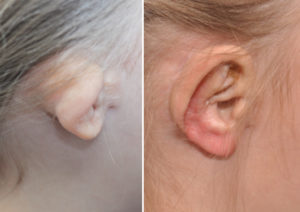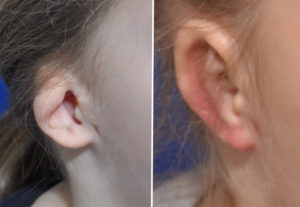Background: One of the most common congenital malformations of the external ear is that of the constricted ear deformity. It goes by a number of other names such as lop ear and cup ear. But they all fall under that of an ear constriction issue. Think of the outer helical rim as a draw string and all types of constricted ears appear based on how tight the draw string is pulled. Underlying all of the presentations of the constricted ear is that some amount of tissue deficiency (skin and cartilage) exist.
The constricted ear appears in a variety of manifestations. In all types the top of the helical rim is folded over. (hence the term lop ear) In more severe forms the cartilage of the helical rim and scapula is deficient creating a tighter roll and small ear. (thus the term cup ear) The one consistent difference between a constricted ear and microtia is that an external auditory canal is present the former but not in the latter.
Reconstruction methods of the constricted ear depend on the severity of the deformity. In more severe forms cartilage grafts are needed. This in most cases means that a rib graft framework needs to be used to create the deficient upper east cartilage.
Case Study: This 7 year-old female was born with a severely constricted ear and multiple skin tags. As an infant her skin tags were removed.

The constricted ear is a challenging reconstruction which can be only slightly less difficult to do than a complete microtia. It does have the benefits of an existing earlobe, external auditory canal, concha and tragus which help make for a favorable result in many cases.
Highlights:
- Many congenital ear deformities fall into the category of a constricted ear deformity with contraction around the helical rim due to underdevelopment.
- Reconstruction of the underdeveloped ear framework requires an autologous rib graft method.
- The constricted ear deformity requires multiple stages of reconstruction to achieve its final effect.



